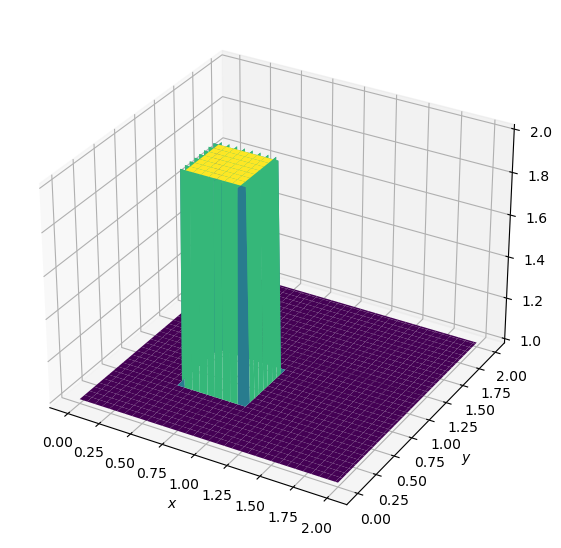Step 8: 2-D Convection#
Now we solve 2D Convection, represented by the pair of coupled partial differential equations below:
Discretizing these equations using the methods we’ve applied previously yields: $\(\frac{u_{i,j}^{n+1}-u_{i,j}^n}{\Delta t} + u_{i,j}^n \frac{u_{i,j}^n-u_{i-1,j}^n}{\Delta x} + v_{i,j}^n \frac{u_{i,j}^n-u_{i,j-1}^n}{\Delta y} = 0\)$
Rearranging both equations, we solve for \(u_{i,j}^{n+1}\) and \(v_{i,j}^{n+1}\), respectively. Note that these equations are also coupled.
Initial Conditions#
The initial conditions are the same that we used for 1D convection, applied in both the x and y directions.
Boundary Conditions#
The boundary conditions hold u and v equal to 1 along the boundaries of the grid .
from mpl_toolkits.mplot3d import Axes3D
from matplotlib import pyplot as plt, cm
import numpy as np
# declare variables
nx = 101
ny = 101
nt = 80
c = 1
dx = 2 / (nx - 1)
dy = 2 / (ny - 1)
sigma = 0.2
dt = sigma * dx
x = np.linspace(0,2,nx)
y = np.linspace(0,2,ny)
u = np.ones((nx,ny))
v = np.ones((nx,ny))
un = np.ones((nx,ny))
vn = np.ones((nx,ny))
# assign initial conditions
##set hat function I.C. : u(.5<=x<=1 && .5<=y<=1 ) is 2
u[int(.5 / dx):int(1 / dx + 1), int(.5 / dy):int(1 / dy + 1)] = 2
##set hat function I.C. : v(.5<=x<=1 && .5<=y<=1 ) is 2
v[int(.5 / dx):int(1 / dx + 1), int(.5 / dy):int(1 / dy + 1)] = 2
fig = plt.figure(figsize = (11,7), dpi=100)
ax = fig.add_subplot(111, projection='3d')
# The '111' means a grid of 1 row and 1 column and this subplot is the first one.
X, Y = np.meshgrid(x,y)
surf = ax.plot_surface(X,Y,u,cmap=cm.viridis)
ax.set_xlabel('$x$')
ax.set_ylabel('$y$');

$\(v_{i,j}^{n+1} = v_{i,j}^n - u_{i,j} \frac{\Delta t}{\Delta x} (v_{i,j}^n-v_{i-1,j}^n) - v_{i,j}^n \frac{\Delta t}{\Delta y} (v_{i,j}^n-v_{i,j-1}^n)\)$
for n in range(nt): # we will use array operations to replace nested for-loops
un = u.copy()
vn = v.copy()
u[1:,1:] = (un[1:,1:] -
(un[1:,1:] * c * dt / dx * (un[1:,1:] - un[:-1,1:])) -
vn[1:,1:] * c * dt / dy * (un[1:,1:] - un[1:,:-1]))
v[1:,1:] = (vn[1:,1:] -
(un[1:,1:] * c * dt / dx * (vn[1:,1:] - vn[:-1,1:])) -
vn[1:,1:] * c * dt / dy * (vn[1:,1:] - vn[1:,:-1]))
u[0,:] = 1
u[:,0] = 1
v[0,:] = 1
v[:,0] = 1
fig = plt.figure(figsize = (11,7), dpi=100) # Adjust the size to accommodate two plots
ax1 = fig.add_subplot(121, projection='3d') # The '121' means a grid of 1 row and 2 columns, and this is the first plot
X, Y = np.meshgrid(x,y)
surf1 = ax1.plot_surface(X,Y,u,cmap=cm.viridis)
ax1.set_xlabel('$x$')
ax1.set_ylabel('$y$')
ax1.set_title('Plot of u')
ax2 = fig.add_subplot(122, projection='3d') # The '122' means a grid of 1 row and 2 columns, and this is the second plot
surf2 = ax2.plot_surface(X,Y,v,cmap=cm.viridis)
ax2.set_xlabel('$x$')
ax2.set_ylabel('$y$')
ax2.set_title('Plot of v')
plt.show()

